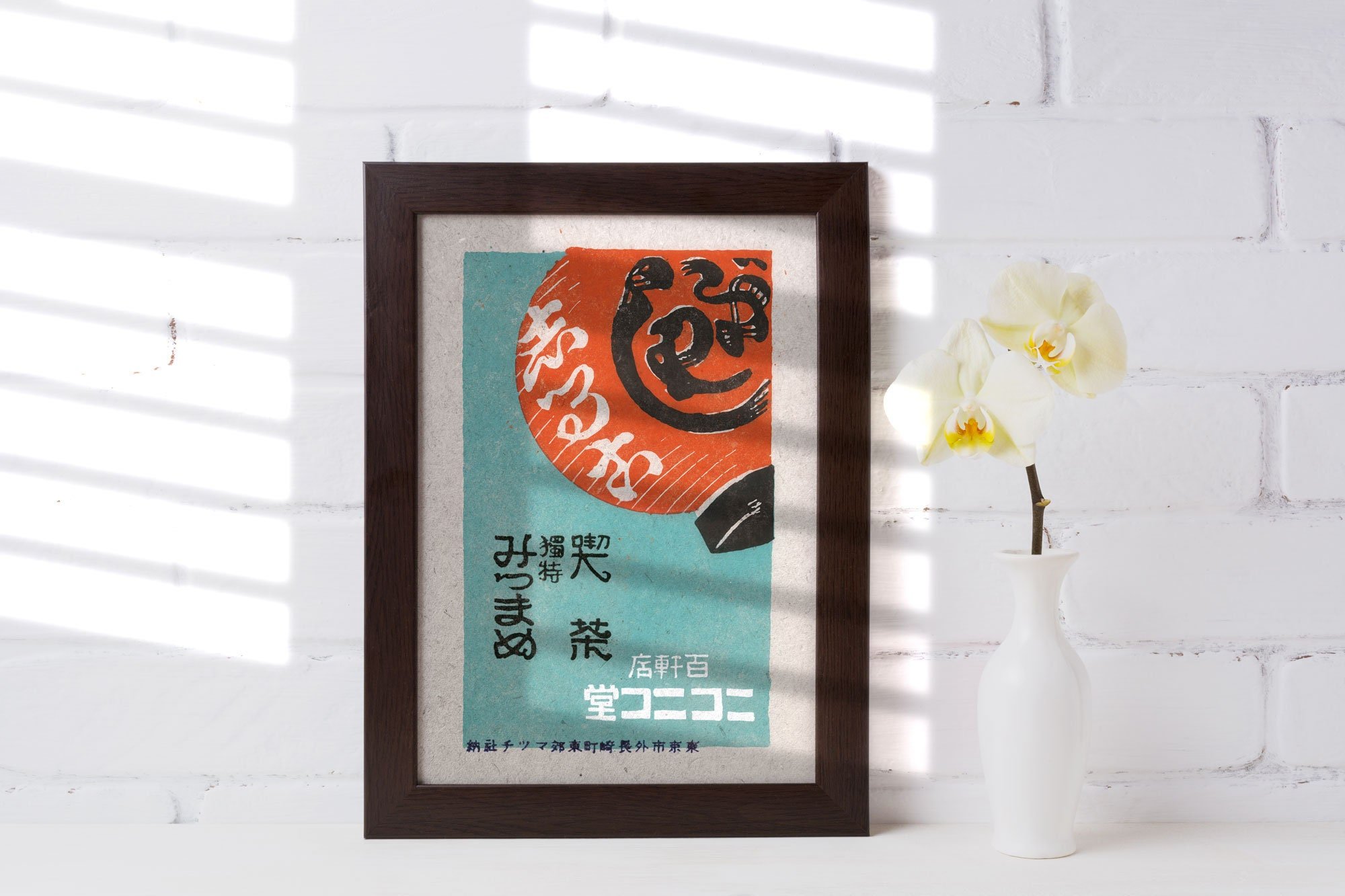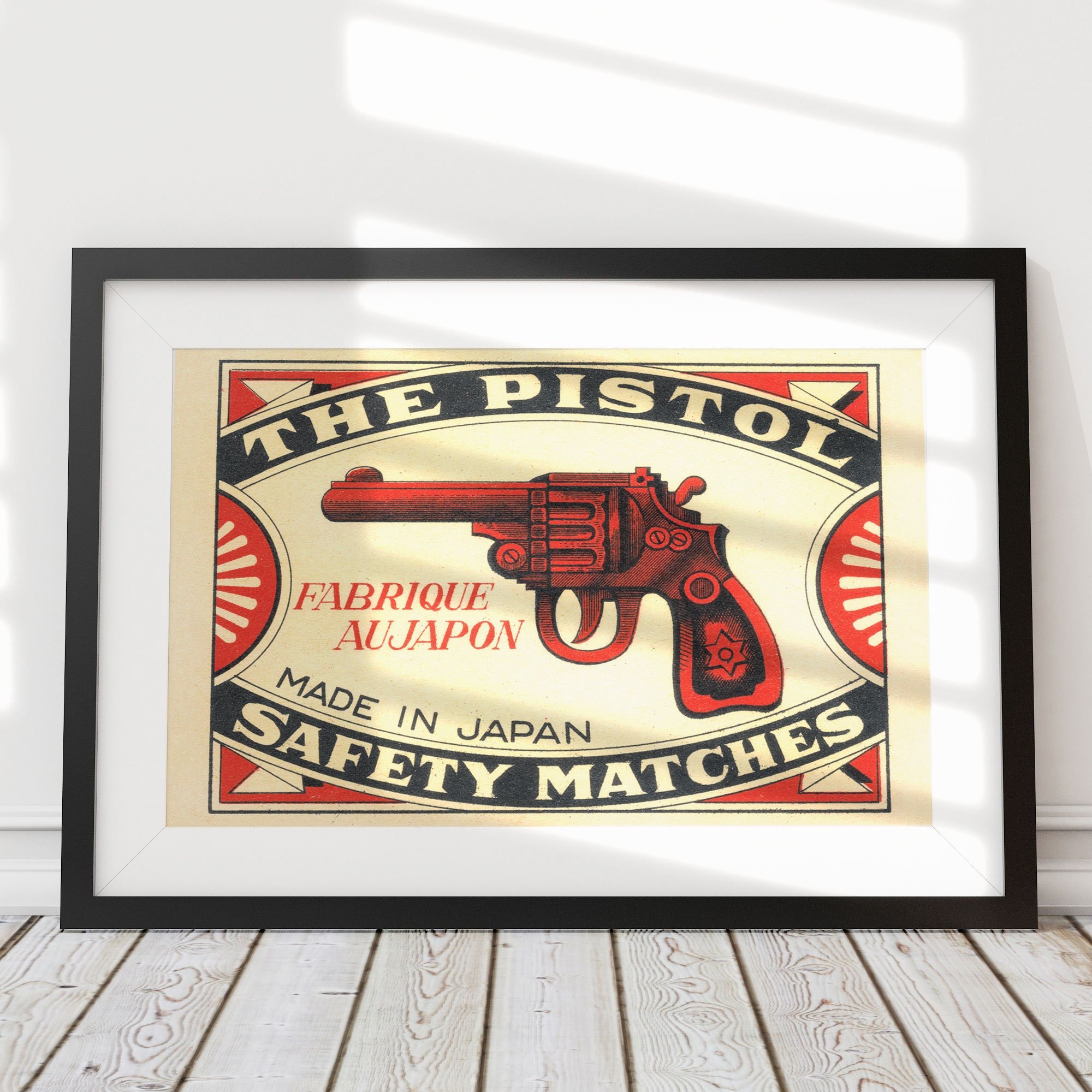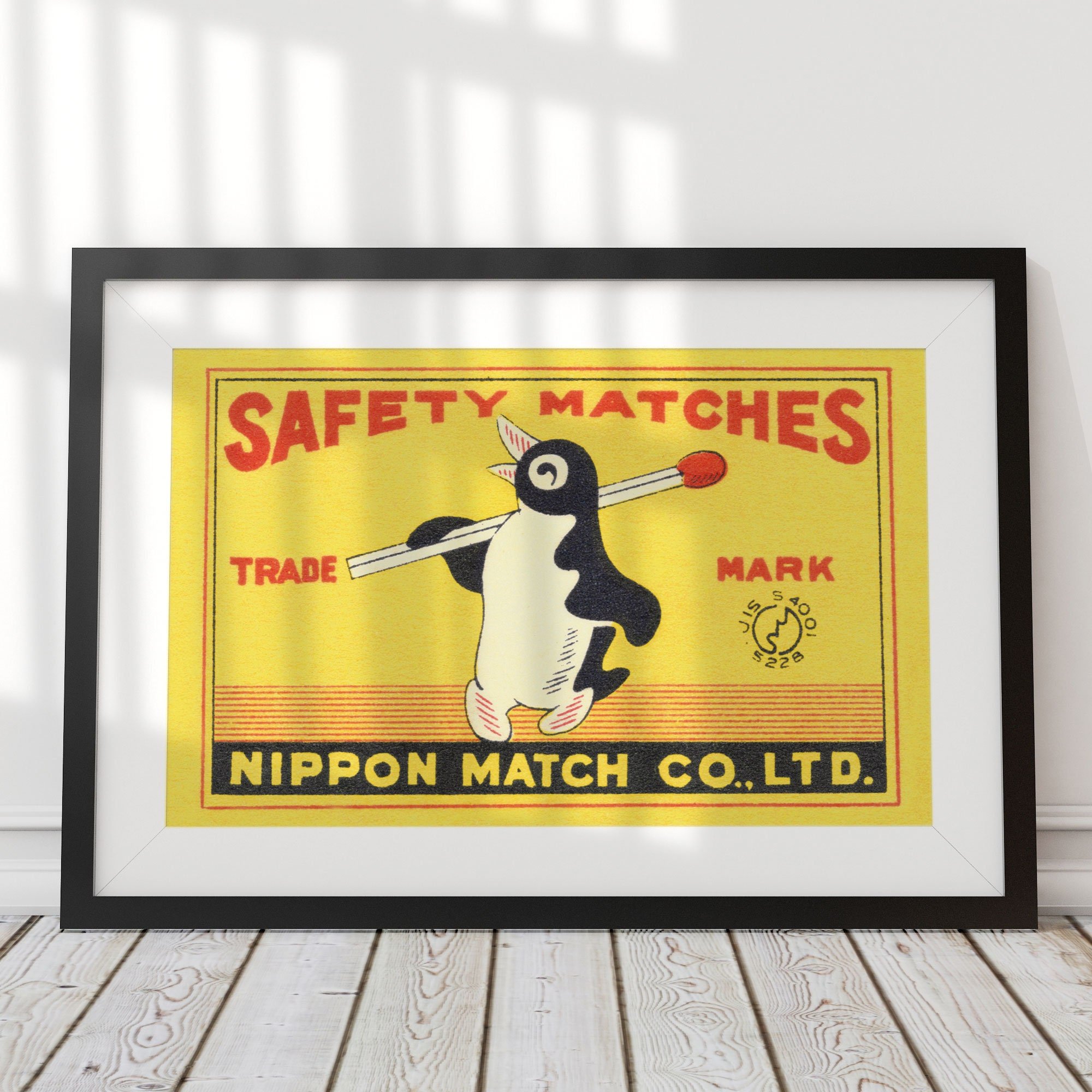 Image 1 of 4
Image 1 of 4

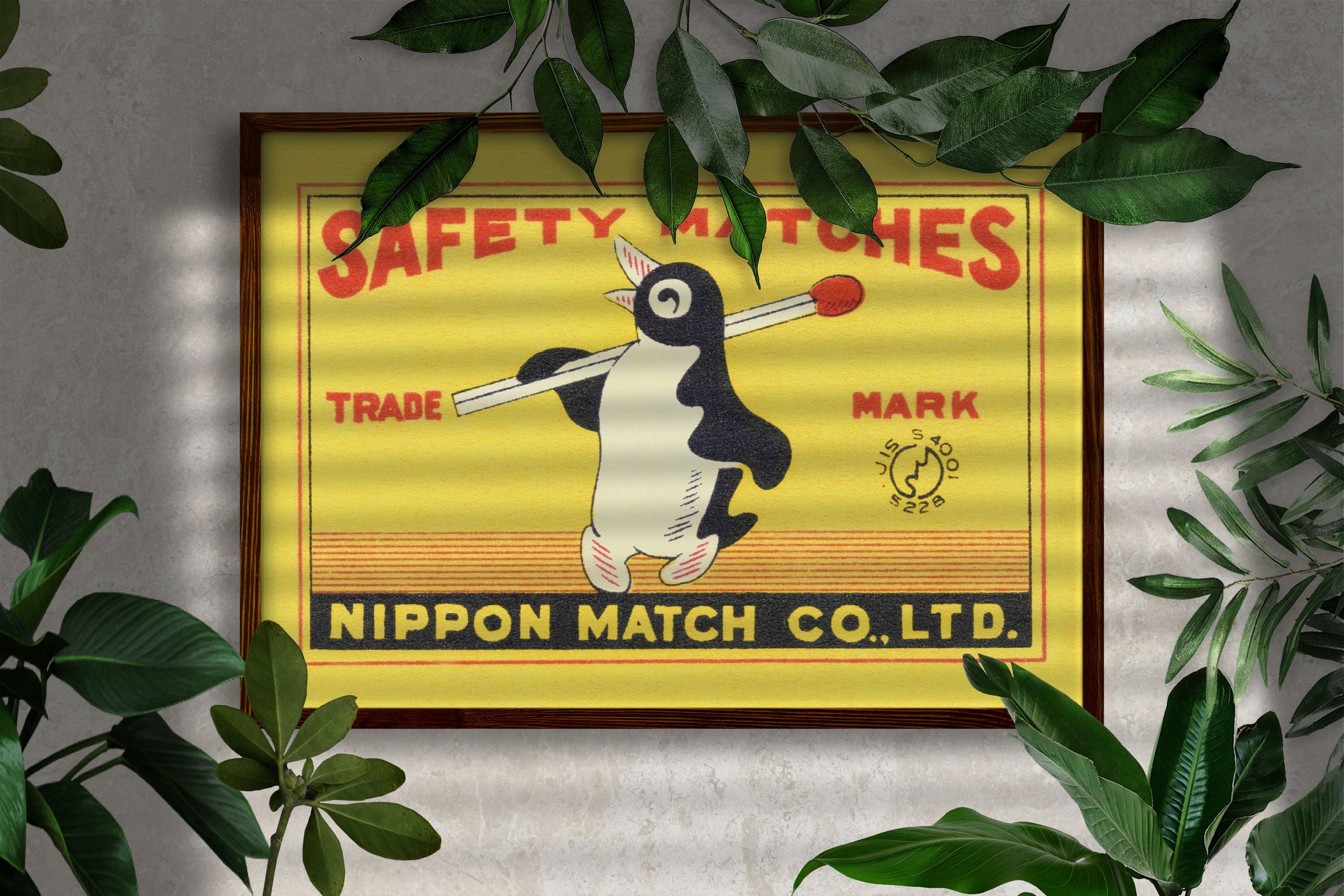 Image 2 of 4
Image 2 of 4

 Image 3 of 4
Image 3 of 4

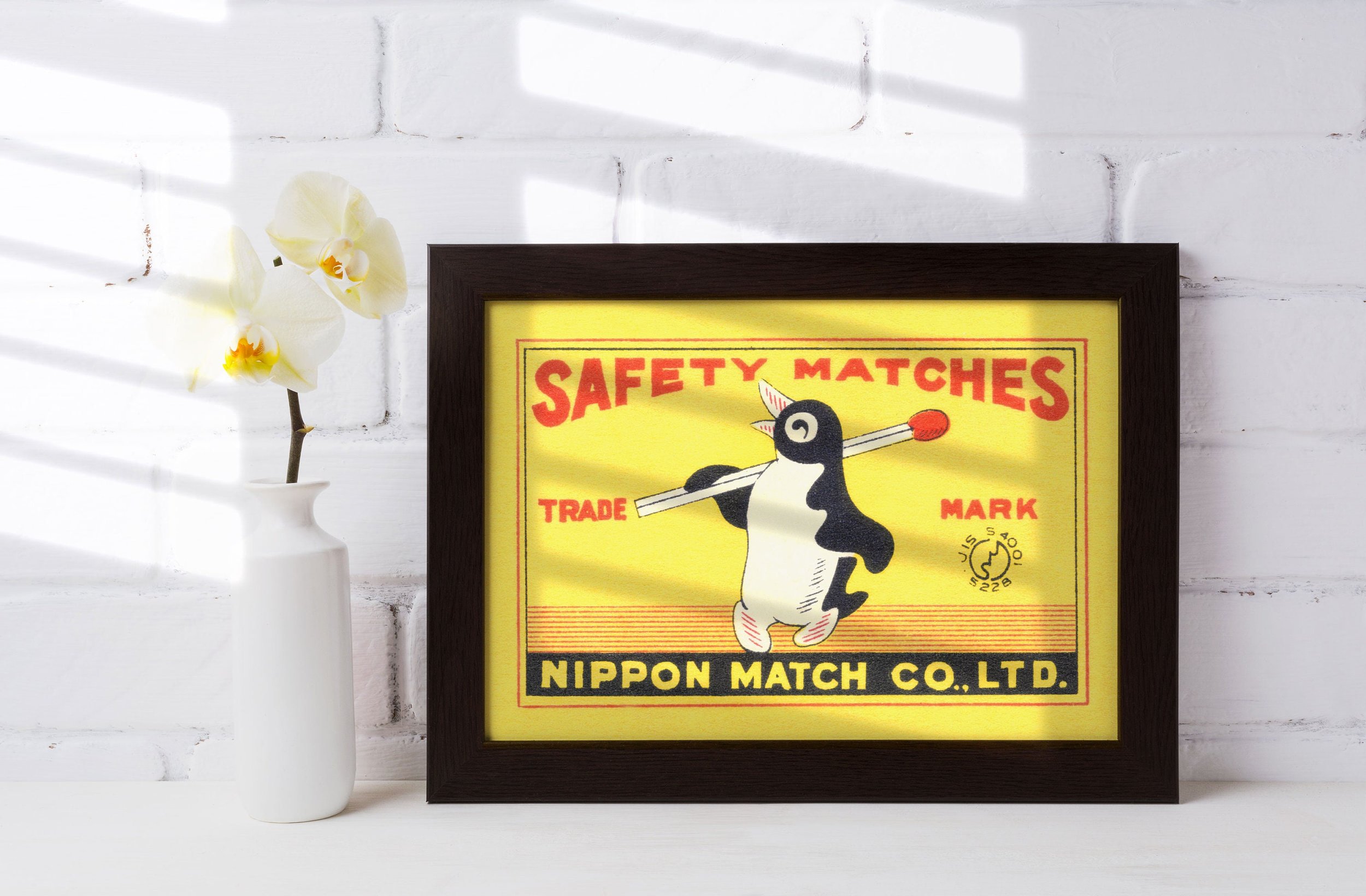 Image 4 of 4
Image 4 of 4





Yellow Penguin Holding A Matchstick - Vintage Japanese Matchbox Label Unframed A3 A4 A5 Art Print
from £8.99
My prints are based on vintage matchbox labels from Japan. I was fascinated by these designs on my first trip there, and was amazed to see such bold and evocative images on such tiny items. I began to research and collect examples, from which I have developed my prints.
The match industry was important in Japan at the turn of the 19th / 20th century and box labels advertised the brand, as well as being used by newly-established cafes, bars and hotels as advertising. Since smoking was much more popular then, it was a very effective strategy.
Matchbox label design became an art form in its own right and people began to save and collect the labels. This led to special-edition sets of matchboxes being produced and top designers being commissioned.
Many of these designs retain a charm and mark a moment in history of forward-looking Japan at the beginning of the 20th century, which I hope you will enjoy with me.
So why is my name Grumpy Daruma? Well, on that trip to Japan I also fell in love with ‘Daruma dolls’ – papier mache embodiments of the Zen Buddhist Bodidharma who is depicted with a grumpy expression (probably from meditating for 7 years straight). I feel it suits me well.
All of my prints are on high quality 300gsm recycled, uncoated paper, and come with a sturdy backing board and plastic sleeve. I chose this particular paper because it has a textured, slightly flecked appearance which works well with the matchbox designs. This paper is more absorbent than coated varieties, so the finished print appears flatter.
The match industry was important in Japan at the turn of the 19th / 20th century and box labels advertised the brand, as well as being used by newly-established cafes, bars and hotels as advertising. Since smoking was much more popular then, it was a very effective strategy.
Matchbox label design became an art form in its own right and people began to save and collect the labels. This led to special-edition sets of matchboxes being produced and top designers being commissioned.
Many of these designs retain a charm and mark a moment in history of forward-looking Japan at the beginning of the 20th century, which I hope you will enjoy with me.
So why is my name Grumpy Daruma? Well, on that trip to Japan I also fell in love with ‘Daruma dolls’ – papier mache embodiments of the Zen Buddhist Bodidharma who is depicted with a grumpy expression (probably from meditating for 7 years straight). I feel it suits me well.
All of my prints are on high quality 300gsm recycled, uncoated paper, and come with a sturdy backing board and plastic sleeve. I chose this particular paper because it has a textured, slightly flecked appearance which works well with the matchbox designs. This paper is more absorbent than coated varieties, so the finished print appears flatter.
Dimensions:
Quantity:
Add To Cart
My prints are based on vintage matchbox labels from Japan. I was fascinated by these designs on my first trip there, and was amazed to see such bold and evocative images on such tiny items. I began to research and collect examples, from which I have developed my prints.
The match industry was important in Japan at the turn of the 19th / 20th century and box labels advertised the brand, as well as being used by newly-established cafes, bars and hotels as advertising. Since smoking was much more popular then, it was a very effective strategy.
Matchbox label design became an art form in its own right and people began to save and collect the labels. This led to special-edition sets of matchboxes being produced and top designers being commissioned.
Many of these designs retain a charm and mark a moment in history of forward-looking Japan at the beginning of the 20th century, which I hope you will enjoy with me.
So why is my name Grumpy Daruma? Well, on that trip to Japan I also fell in love with ‘Daruma dolls’ – papier mache embodiments of the Zen Buddhist Bodidharma who is depicted with a grumpy expression (probably from meditating for 7 years straight). I feel it suits me well.
All of my prints are on high quality 300gsm recycled, uncoated paper, and come with a sturdy backing board and plastic sleeve. I chose this particular paper because it has a textured, slightly flecked appearance which works well with the matchbox designs. This paper is more absorbent than coated varieties, so the finished print appears flatter.
The match industry was important in Japan at the turn of the 19th / 20th century and box labels advertised the brand, as well as being used by newly-established cafes, bars and hotels as advertising. Since smoking was much more popular then, it was a very effective strategy.
Matchbox label design became an art form in its own right and people began to save and collect the labels. This led to special-edition sets of matchboxes being produced and top designers being commissioned.
Many of these designs retain a charm and mark a moment in history of forward-looking Japan at the beginning of the 20th century, which I hope you will enjoy with me.
So why is my name Grumpy Daruma? Well, on that trip to Japan I also fell in love with ‘Daruma dolls’ – papier mache embodiments of the Zen Buddhist Bodidharma who is depicted with a grumpy expression (probably from meditating for 7 years straight). I feel it suits me well.
All of my prints are on high quality 300gsm recycled, uncoated paper, and come with a sturdy backing board and plastic sleeve. I chose this particular paper because it has a textured, slightly flecked appearance which works well with the matchbox designs. This paper is more absorbent than coated varieties, so the finished print appears flatter.
My prints are based on vintage matchbox labels from Japan. I was fascinated by these designs on my first trip there, and was amazed to see such bold and evocative images on such tiny items. I began to research and collect examples, from which I have developed my prints.
The match industry was important in Japan at the turn of the 19th / 20th century and box labels advertised the brand, as well as being used by newly-established cafes, bars and hotels as advertising. Since smoking was much more popular then, it was a very effective strategy.
Matchbox label design became an art form in its own right and people began to save and collect the labels. This led to special-edition sets of matchboxes being produced and top designers being commissioned.
Many of these designs retain a charm and mark a moment in history of forward-looking Japan at the beginning of the 20th century, which I hope you will enjoy with me.
So why is my name Grumpy Daruma? Well, on that trip to Japan I also fell in love with ‘Daruma dolls’ – papier mache embodiments of the Zen Buddhist Bodidharma who is depicted with a grumpy expression (probably from meditating for 7 years straight). I feel it suits me well.
All of my prints are on high quality 300gsm recycled, uncoated paper, and come with a sturdy backing board and plastic sleeve. I chose this particular paper because it has a textured, slightly flecked appearance which works well with the matchbox designs. This paper is more absorbent than coated varieties, so the finished print appears flatter.
The match industry was important in Japan at the turn of the 19th / 20th century and box labels advertised the brand, as well as being used by newly-established cafes, bars and hotels as advertising. Since smoking was much more popular then, it was a very effective strategy.
Matchbox label design became an art form in its own right and people began to save and collect the labels. This led to special-edition sets of matchboxes being produced and top designers being commissioned.
Many of these designs retain a charm and mark a moment in history of forward-looking Japan at the beginning of the 20th century, which I hope you will enjoy with me.
So why is my name Grumpy Daruma? Well, on that trip to Japan I also fell in love with ‘Daruma dolls’ – papier mache embodiments of the Zen Buddhist Bodidharma who is depicted with a grumpy expression (probably from meditating for 7 years straight). I feel it suits me well.
All of my prints are on high quality 300gsm recycled, uncoated paper, and come with a sturdy backing board and plastic sleeve. I chose this particular paper because it has a textured, slightly flecked appearance which works well with the matchbox designs. This paper is more absorbent than coated varieties, so the finished print appears flatter.





